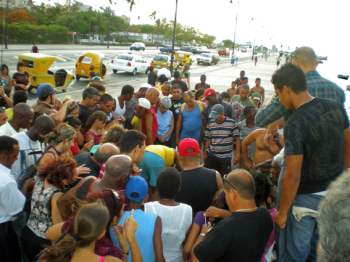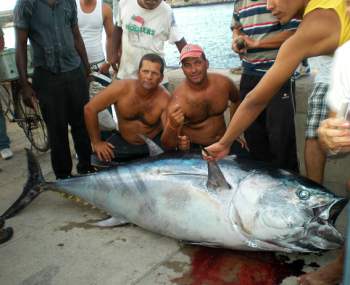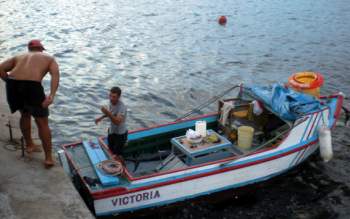A Tuna on the Pavement
Isbel Diaz Torres

Almost a hundred people crowded around on Puerto Avenue, curious to see the fine fishing trophy they found there. It was an enormous tuna. One that was well over than six feet long that had been caught off of Havana’s malecón (seawall).
“It must weigh between 400 and 500 pounds,” assured one onlooker who had the look of a fisherman. The experts occupied themselves trying to guess the weight and the exact species. According to the Encyclopedia Encarta, “tuna” is the common name of not one, but of several fish in the Scombridae family, so it wasn’t so difficult to guess it right.
The specimen in question was beautiful; it’s a shame it was dead. It was of a metallic blue color on its back (as readers can see in the photo), and its stomach was silver. I also found what appeared to be small yellow blades jutting out of the area toward its back fin to be very attractive. In reality these were bony keels formed by extensions of the lower vertebrae of the fish.
These animals are a marvel of nature and can attain high speeds thanks to the hydrodynamic design of their bodies. This allows them to escape their predators and to roam great distances to reach their spawning and feeding areas.

One could see the look of astonishment and excitement in the faces of the fishermen who gathered, causing me to think that catching a fish like this wasn’t something so common here along the malecon. The pollution that has affected Havana Bay and its surroundings areas for years has very negatively impacted marine life here.
A certain degree of visible recovery around the bay has been experienced thanks to major investment in environmental remediation, in addition to the impact of economic crisis, which has meant the arrival of less merchant vessels than many people would like to see. In addition, the rumors of a possible transfer of heavy and dirtier harbor functions to Mariel Bay, to the west of Havana, if true, bode well for the future of the waterfront here in the capital.
To capture this tuna it’s very possible that the Victoria (the small fishing craft of these fishermen) must have distanced itself from the dark waters of our bay. With the arrival of summer, these fish come a little closer to the coast to spawn.
Notwithstanding the beauty of the fish, the expression of death on its face could not be overlooked. That happens when the gills lack a continuous flow of water through them. If they stop swimming, the fish die of anoxia, something that must be a very sad end. That’s why their struggles with the fisherman are so tenacious.

Have you started thinking about a living being that can’t stop moving? It’s wonderful and terrible. I always think about the problems one would have with the police in Havana, who always limit people’s movement (we should remember that even walking too slowly raises a red flag with them).
In principle, I’m against sport fishing. I find it aberrant to seek pleasure in the murder of another living being. There are cases in which the measures taken are extremely violent, which also show what type of society we’ve designed – in a rush to win, willing to sacrifice whatever.
But those who hunt or fish to live possess a different spirit. Those people are less hypocritical than those who buy frozen fish in the fish market, or the person who turns their face away when they slit a pig’s throat and later eats the pork chops on the table.
Anyone who hunts or fishes for a living knows about the pain of the animal, and they know about their own sweat that goes into trying to earn their sustenance. To eat what you kill makes a person hard, but they also learn to respect their prey. I hope the two men who caught the tuna can eat a good portion of it or that they can sell it to make some good money for their families.
When I was taking the photo, I was going to crop out the blood on the pavement, but I overcame that hypocrisy and I took the full photo. I’m hoping this doesn’t upset anyone too much.






As I said in the article, Havana Bay has been cleaned during the last decades, thanks to international projects, since it is a very hard and expensive work. There are a lot of people working to clean the water and the bottom, and they have partially succeeded. There are educational programs to revert the impact of human pollution also. One of the measures is to move the Puerto from Havana to Mariel.
Also, old industries send their wastes to the bay, and Cuba has no money to update them. The answer is to close (and there are some of them already closed).
Water quality have been improved, and life has returned to the bay, but it is a slow process.
Thanks for your comments
If the waters in havana bay are that bad then why dosnt someone clean up the mess hire divers to clean up the mess left by years of abuse and what makes it worse if this is true then what about the water you bathe and drink from there must be a solution and an answer to all of the above but it won’t get done by itself.